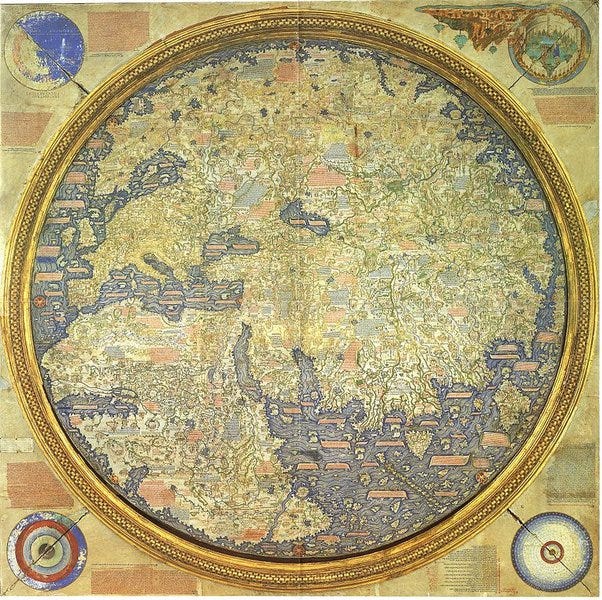I love maps
A paper map is a symbol of the human pursuit of understanding.
Before the scientific revolution, maps were full. A British map had detailed markings everywhere but it had one problem. It was missing two continents. It didn’t have a blank space with “TBD” over undiscovered areas, or a massive empty ocean. It had little unused space, artificially shrinking the space between Asia and Europe across the Atlantic.
world map before the discovery of America
This map symbolizes societal attitudes before the Scientific Revolution - unable to admit ignorance.
It was only after the European powers began sending out massive (by 1800s standards) ships filled with not just military personnel, but also dozens or even hundreds of scientists, that the maps changed. They didn’t just change to represent newly discovered lands.
They changed the amount of empty space between continents. Suddenly, the map was mostly empty, implying massive ignorance.
A New Age of Discovery
The new map symbolizes a new age of curiosity and discovery.
Today, the entire world and even parts of our solar system have been mapped. There are all new types of maps now: street maps, elevation maps, population density maps, political maps and so much more. The issue of mapping has changed today.
What is a Map?
A map is a simplified representation of the playing field.
We use mental maps all the time without realizing it. Life is complex. Every single thing we do is complex. Consider trying to eat healthy. We have a map that charts calories, protein, carbohydrates and fats. Most diets adhere to this map. But the actual nutrition content of the food is more than just the map.
What if we didn’t have these metrics and instead when you bought a food and look at the packaging, there were just pictures of each amino acid chain and you had to use that to determine how healthy the food was. A different type of map to navigate the same issue - nutrition.
It wouldn’t be wrong. The information on the amino acid chains could be completely correct and at the same time totally useless. Now we see the importance of the map we use.
A diet map using calories and macronutrients on a label is (in 99% of cases) more useful than a map of the amino acids.
A Guide To Paris
Each situation calls for a different map. An example I like from “The Great Mental Models: General Thinking Concepts” is of a tourist visiting Paris. What if you bought a “Guide-to-Paris” that was so infinitely detailed than you needed to buy a “Guide-to-the-Guide-to-Paris” and so on until you finally get a book that says “sit at X cafe for a few hours and don’t try to speak French or they’ll be mean to you.” The level of detail in a map can change it’s usefulness.
The map is not the territory. A map must be simplified to useful. But when it comes time to act, you act in the real world, not in the “map” world. That real world IS full of complexity not shown on the map.
It can be tempting to make decisions without ever seeing the real world. It’s tempting to decide the good guys and bad guys in a conflict in a region of the world I’ve never been to because I’ve been shown a clear and simple “map”. But the map is necessarily simplified.
The map is a symbol.
The map is simple.
The map is not the territory.
Question of The Day
Have you ever been driving and a road is closed that the map didn’t tell you about? The map is not the territory.
Your Friend,
Noah “BigNerd” Sochaczevski


